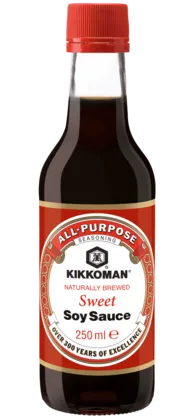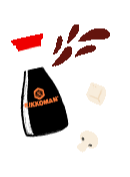What's the difference between soy sauce and shoyu?
07. August 2023

The difference between soy sauce and shoyu
Japanese Soy Sauce/shoyu

Shoyu is the term broadly given to Japanese style soy sauces that are made from fermented soybeans, wheat, salt and water. In general, they are quite thin and clear and are a good all-purpose cooking and table sauce.
Kikkoman soy sauce is the best-selling shoyu in the world. It has a complex natural brewing (fermentation) process – a special aspergillus mould is added to steamed soy beans and roasted wheat to produce a “koji” mash to which water and salt is added. This mixture called “moromi” is then left to naturally brew and develop in flavour and aroma over several months. After this time the moromi is slowly pressed and filtered to extract the raw soy sauce, then pasteurized to preserve the intense flavour and quality of the soy sauce. This is a much-simplified description, but the whole process is very involved and essential for producing Kikkoman’s unique umami-rich taste and over 300 different flavour profiles can be detected such as fruits, vanilla, coffee and whisky!
Chinese soy sauces

Other types of soy sauce such as Chinese soy sauce are very different in style to shoyu. These tend to be chemically produced or partially brewed using little or no wheat or yeast and come in light and dark varieties.
Where Japanese shoyu contains just 4 ingredients, you can expect to see a minimum of 11-12 ingredients in Chinese soy sauces. Dark Chinese soy sauces often have caramel colouring E150 added to them and are thicker in texture and can have a sweetish aftertaste, and the light Chinese soy sauces often have a higher salt content than Japanese shoyu. They also do not have the same level of translucence and can look a bit "muddy".
Kikkoman can be easily substituted for both light and dark soy sauces in recipes, whether in stir-fries, marinades, dipping sauces, dressings or as a universal seasoning in any type of dish.
Light vs dark soy sauce
As mentioned above Chinese soy sauce's come in two varieties that are very different to Japanese Shoyu. These are light and dark soy sauces, but what are the differences?
Light soy sauce, as well as being lighter in colour has a thinner texture and is typically saltier. You may often find light soy sauce used in Cantonese style cooking.
Dark soy sauce is a thicker and sweeter sauce than it's lighter alternative. This version of soy sauce is often used to coat meats and add colour to dishes.
Indonesian soy sauce

Kecap manis is an Indonesian style of soy sauce with added palm sugar molasses and other ingredients such as ginger, garlic, curry leaves etc. It is thick and syrupy and very different to other types of soy sauce.
Does Soy Sauce Contain Alcohol?
Kikkoman Naturally Brewed Soy Sauce contains <2% alcohol by volume. The alcohol is not added as an ingredient, but is a result of the natural fermentation process whereby the wheat starches are broken down to sugars and part of the sugar is changed into alcohol.
If you require a wheat-free soy sauce then you can use Kikkoman Tamari Gluten-free Soy Sauce. It is also certified halal by the Halal Feed And Food Inspection Authority (HFFIA) and their logo is on the bottle label.
Kikkoman also makes other soy sauces

- Kikkoman Tamari Gluten-free Soy Sauce is a wheat-free soy sauce which contains just soybeans, water, salt and spirit vinegar and can be enjoyed by those avoiding wheat or with coeliac disease. The absence of wheat means that no alcohol is produced as a fermentation by-product and therefore is also suitable for halal diets.
- Kikkoman Less Salt has 43% less salt than the original but doesn’t compromise on taste.
- Kikkoman Ponzu is a lemon seasoned soy sauce and has a delicate sweet-sharp taste. Try it sprinkled over fish and chips or as a salad dressing.
- Kikkoman Sweet Soy Sauce has added sugar and is great drizzled over rice or as a dip.






![[Translate to Englisch (UK):] [Translate to Englisch (UK):]](https://www.kikkoman.co.uk/fileadmin/_processed_/9/4/csm_Blogpage_How_To_Master_Velveting_Desktop-Header_f36d5cca18.webp)


![[Translate to Englisch (UK):] [Translate to Englisch (UK):]](https://www.kikkoman.co.uk/fileadmin/_processed_/0/d/csm_928-recipe-page-prawn-and-vegetable-stir-fry-noodles_mobile_78dc5b25bc.webp)
![[Translate to Englisch (UK):] [Translate to Englisch (UK):]](https://www.kikkoman.co.uk/fileadmin/_processed_/c/d/csm_1039-recipe-page-Easy-Carrot-soup_mobile_7366116d92.webp)
![[Translate to Englisch (UK):] [Translate to Englisch (UK):]](https://www.kikkoman.co.uk/fileadmin/_processed_/c/5/csm_MainDishes_recipe-collection_desktop_2x_ef5962097e.webp)
![[Translate to Englisch (UK):] [Translate to Englisch (UK):]](https://www.kikkoman.co.uk/fileadmin/_processed_/b/e/csm_1101-recipe-page-Authentic-Japanese-soy-sauce-ramen_mobile_6bf05afcae.webp)
![[Translate to Englisch (UK):] [Translate to Englisch (UK):]](https://www.kikkoman.co.uk/fileadmin/_processed_/e/b/csm_918-recipe-page-pumpkin-hummus_mobile_d372eb934b.webp)




